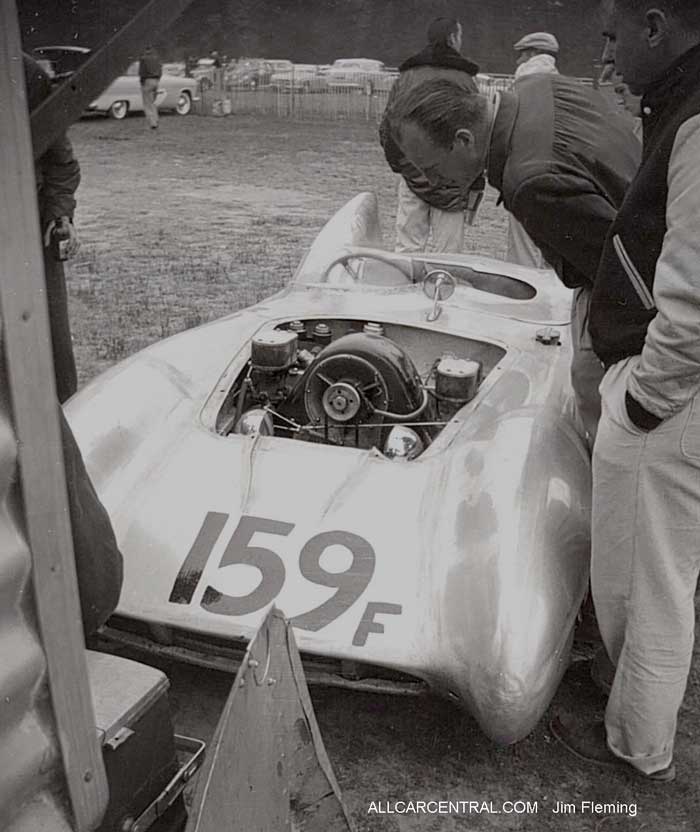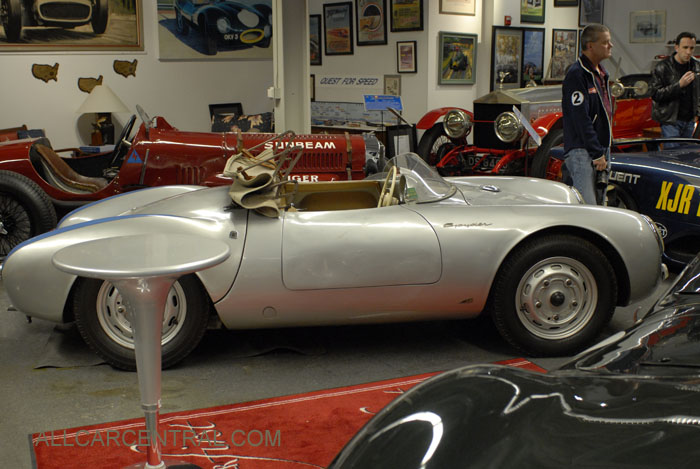
Interesting Photograph - my friend, Jim Fleming, took it more than fifty years ago. The
Lotus Mark IX was parked in the paddock at the Pebble Beach Races. I'm standing
behind the car in the fur trimmed dark car coat. There's quite a story about this Lotus -
actually a tale of two Lotuses caught up in the mysterious events surrounding James
Dean's death.
I knew the Lotus in Jim's photograph as the "Potus." I'm not sure who originally came up
with the name Potus, but that was the acronym which Dr. Troy McHenry used when he
described the car to my father earlier that year. Dr. McHenry was a Southern California
physician, enthusiastic sports car racer, and a good friend of my father. He'd confided to my father that the Potus might be even faster than his Porsche Spyder on the tree lined
race course winding through the Del Monte Forest.
High praise indeed! Porsche 550 Spyders were the cars to beat in the under 1500cc racing
class at the time.
Saturday morning, April 21, 1956: Jim and I were winding down from an adrenalin-pumping early morning run in my MG TC from Berkeley to The Monterey Peninsula
(The Road to Pebble Beach: Victory Lane - October 2005). Now we were in The Del
Monte Forest, looking over the array of race cars in the paddock that would compete the
next day in the Pebble Beach Races. Tall cypress trees, their tops shrouded in heavy mist,
stood wraithlike. Everybody wore warm jackets. (Author, Peter Darnall can be seen in background, of the above photo, in the car-coat with the large fur collar.) It was almost noon, but the gray overcast gave no indication of lifting.

Program Page showing The Lotus Mark IX entered
The Potus had been drawing the attention of curious spectators that morning. Essentially the car was a Lotus Mark IX fitted with a Porsche 4-cam engine. The hood had been removed and the Porsche engine with its tall fan housing seemed somewhat incongruous in the Lotus' front engine bay. The engine, according to a sign beside the car, was the actual unit salvaged from James Dean's wrecked Porsche Spyder. The aura of James Dean, the actor, and the mysterious circumstances surrounding his violent death a few months earlier seemed uncomfortably close that cold foggy morning. My program for the races listed the Potus only as a Lotus and assigned the number 159 to the car. Dr.William Eschrich (with his name slightly misspelled) as the owner and driver, was scheduled to compete in the Under 1500cc Modified Group. Dr. McHenry's Porsche Spyder was also running in the same group.
James Dean
James Dean had been a young Hollywood movie star who gained considerable fame for his portrayal of teenage angst starring in the role of Jim Stark in the movie "Rebel Without a Cause." Dean had become interested in sports car racing and actually showed promise as a novice driver in the few events he ran with his Porsche Speedster. Looking for a faster ride, he purchased a Porsche 550 Spyder and entered the car for its competition debut in the race event scheduled for late September at the Salinas Airport. To familiarize himself with the Spyder, he decided to drive the car from Los Angeles to Salinas accompanied by his mechanic, Rolf Wütherich. Tragically, James Dean died driving the Porsche on the public highway in a head-on collision en route to the races. A cloud of mystery surrounds the event and a memorial erected in the town of Cholame lies close to the intersection of State Routes 41 and 46, where Dean died. He was 24 years old at the time. Rolf Wütherich, Dean's passenger, survived the crash but died a few years later in a car crash in Germany.
Dr. William Eschrich
Dr. William Eschrich, a Southern California physician and active sports car racer, had
campaigned an Offenhauser-engined Special in Cal Club events with some success. He
had acquired a Mark IX Lotus, intending to install an Offenhauser engine. James Dean's
crash and the availability of the wrecked Porsche Spyder unexpectedly changed Dr.
Eschrich's plans. The chance to acquire the exotic four-cam Porsche engine was too good
to pass up.
Dr. Eschrich and his friend, Dr. Troy McHenry, acquired the badly twisted remains of
the Spyder from the insurance company. Dr. McHenry removed certain components for
use on his own Spyder. Dr. Eschrich had the exotic 4-cam engine fitted into the engine
bay of his Lotus.The rest of the wrecked Spyder was beyond any feasible economic
restoration and, I understood, was sold to a wrecking yard for its scrap metal value.
550 Porsche Spyder

The 550 Porsche Spyder became an intregral part of the James Dean legend. Many
people, who knew little or nothing about cars, could readily recognize a Porsche Spyder.
They knew it as "James Dean's car." Not so well known, however, is fact that James Dean
had acquired the Spyder as an interim race car. As he had become more serious about
sports car racing, he decided to replace his Porsche Speedster with a faster and more
challenging car. He placed an order with the Colin Chapman's group in England for a
new Lotus to be delivered without an engine. He intended to install an Offenhauser
engine in the Lotus chassis.
Dean soon became impatient with the long lead time and began to look for another car to
race until the Lotus could be delivered. He found a Porsche 550 Spyder at John von
Neumann's Competition Motors and bought it. He planned to run his first race with the
Spyder at Salinas in late September. To familiarize himself with the sleek racer, he
planned to drive it on the road to the races accompanied with his mechanic, Rolf
Wütherich. Not a bad idea - the 550 Spyder, although austere, complied with FIA
requirements for international competition and was fully equipped for road use.
Soon rumors began to circulate.
James Dean's Lotus eventually arrived in Southern California. No one was able to accept
delivery since Dean had died earlier in the desert crash. The car was put into storage
until his estate could deal with the matter. Soon rumors began to circulate. One story
claimed that the car sat unclaimed for months exposed to the weather on a Los Angeles
dock. Eventually, so the story went, the remains of the Lotus - now little more than a
collection of rusty tubes - was returned to England. Somehow, the sad remnants of the
ex-Dean Lotus transformed into an entirely different Lotus that went on to compete in
local events under a false identity. Skulduggery strongly suspected.
I believed for some time that this anecdote belonged with the other fanciful tales
associated with the James Dean Legend. Shipping companies simply don't leave
merchandise sitting on docks unattended for any length of time. They don't
voluntarily accept the costs of returning unclaimed cargo to the point of origin. The Lotus
was almost certainly put into storage in Los Angeles pending a decision on its disposal.
Dr. Eschrich's Potus and the "unclaimed" Dean Lotus were, I thought, most likely one
and the same car. There just weren't that many of these early Lotuses in Southern
California in the mid-fifties.
I was wrong. There were indeed two Lotuses.
Dr.Eschrich had the opportunity to test drive Lotus dealer Jay Chamberlain's personal
Mark IX at a Palm Springs race event. Obviously impressed with the car's potential, Dr.
Eschrich bought an engineless Mk IX rolling chassis that Chamberlain had in stock. This
Lotus Mark IX, with the Porsche engine installed, was the "Potus" that I saw in the paddock at
Pebble Beach.
James Dean's unclaimed Lotus was not left to deteriorate on the docks. John Timanus, a
well-known Southern California racer, purchased the car, without engine or running
gear, from the Dean Estate. Colin Chapman's group had reportedly used a combination of
early Lotus components. Such substitution wasn't an unusual practice with low volume
specialty companies working with whatever bits and pieces were on hand at the time. The
car soon appeared in race programs as a Lotus MK 8/10, but later campaigned as a Mark
X. At any rate John Timanus ran the car with considerable success using a variety of
engines for several years. I believe the car is now in England undergoing restoration.
Epilogue
The Under 1500cc Modified race for the Pebble Beach Cup in 1956 was loaded with
Porsche 550 Spyders. Pete Lovely, almost unbelievably, stormed into the lead with his
Porsche/Cooper and held off the competition for some time. You may have
seen a picture of him driving with one hand, reaching behind with the other to work the
broken throttle linkage. I don't believe the Potus ran that weekend due to mechanical
problems. The races that year marked the last time the sports cars would race on the beautiful tree lined circuit through the Del Monte Forest . . . far too dangerous, they said.
The Potus competed in a few events after the race at Pebble Beach. The last appearance
for the car was at The Fairgrounds in Pomona in 1956. Dr. Eschrich was dueling for the
lead with Richie Ginther's Porsche Spyder when both cars hit a patch of gravel and spun
off the course and out of the race. The Potus was retired from active racing after the
Pomona event. The Eschrich family still owns the Potus and, I believe, has it safely
tucked away in storage.
Sadly, this event at Pomona was the final race for Dr. McHenry as well. He died instantly
when a steering component failed and his car hit a tree.
* * * * *
More than fifty years have passed since Jim Fleming took the picture of the Potus at
Pebble Beach. The hysteria of the James Dean cult following is now only a distant
memory. Perhaps someday we'll see the Potus run again in some vintage racing event.
I'll be there!




BACK TO TOP